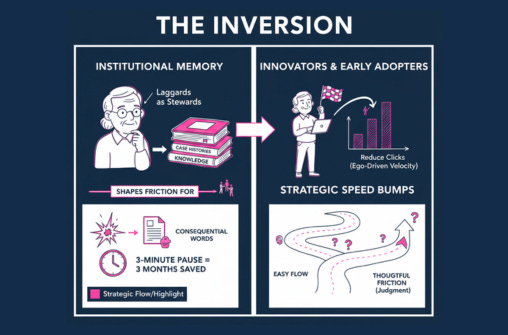FAVOR: If you enjoy our content, please subscribe here on substack, as well as our Podcast, PossibLaw on the various platforms. We greatly appreciate it!
We worship “seamless.” One click. Auto-fill. Skip tutorial. Then a junior legal professional authorizes the wrong clause because the UI made it easy. In legal, “easy” without judgment is a liability. The better move: keep strategic friction that slows people just enough to think, learn, and escalate when it matters.
How do you do that? Focus on inverting the adoption curve. Most product teams map adoption left to right: innovators, early adopters, early majority, late majority, laggards. The playbook is simple: strip friction until everyone glides through. But legal work is not a treadmill. It is a series of decisions under context, precedent, and incentives. When we remove all friction, we also remove the cues that trigger critical thinking. That is how “efficiency” turns into “expensive rework.”
The invisible constraint is ego disguised as velocity. We treat resistance as ignorance rather than signal. We rush to reduce every click without asking which clicks teach the business how to think. Legal needs the opposite reflex: make the right thing easy and the risky thing thoughtful.
Here is the inversion: let the right side of the curve shape friction for the left. Laggards are not always obstacles to avoid. They can be stewards of institutional memory. They know where matters blow up, which words have consequences, and why a three-minute pause saves three months of litigation. Use their judgment to design speed bumps for innovators and early adopters. You still reduce friction, but only where it does not blunt judgment.
Design speed bumps, not walls and Operationalize the Friction
If we invert the adoption curve, the late-side experts help the early-side innovators slow down when it matters all while showing the laggards the value of the new technology. Friction becomes a feature: it slows people only at the moments that build judgment and prevents the weekend fire drill.
How to design friction that teaches
Define instant vs thoughtful: “Standard NDAs: instant. Cross-border DPAs or non-standard indemnities: thoughtful.” This sets the contract for speed.
Map the real failure points: replay the last five messes and mark the exact trigger. Counterparty upload, clause deviation, data transfer, governing law. These are your friction hooks.
Encode judgment in the path: use vetted templates, defaults, and short explainers that answer “why this clause bites.” Keep the good path one click.
Trigger micro-pauses on risk signals: when the counterparty edits liability or adds new data uses, show a plain-English summary and require a short choice: accept standard, request exception with rationale, or escalate.
Progressively reveal complexity: start simple, reveal depth only when answers or metadata cross thresholds. No giant forms; unlock what matters when it matters.
Set a friction budget: cap intentional pause time per workflow. Spend it at the hotspots, not across the whole journey.
Instrument and review weekly: track where people hesitate, overwrite defaults, or escalate. Keep friction that prevented rework; move friction that only added clicks; remove friction where risk has dropped.
Align rewards with good slows: praise clean escalations and first-pass rationales, not just volume. Speed with judgment beats speed alone.
Examples
Self-serve NDAs for sales
Old reflex: remove friction. Auto-generate NDA, auto-send for signature, done. Result: dozens of non-standard exceptions pass quietly because no one paused at the wrong moment.
Inversion: friction only where it teaches. Default to a standard NDA with one-click issue. If a counterparty uploads a modified PDF or requests uncapped indemnity, trigger a “speed bump”: a two-step screen that (a) highlights the deviation with a plain-English summary and (b) requires the salesperson to pick one of three options: accept standard, request exception with business rationale, or escalate to legal. No friction on the happy path; deliberate friction when judgment matters.AI-assisted contract review
Old reflex: strip clicks. Present a binary “approve all suggestions.” Junior reviewers accept machine changes to limitation of liability because accepting everything is faster.
Inversion: friction that builds muscle memory. Group AI suggestions by risk category. For high-impact clauses, require a 30-second justification field and show a short “why this clause bites” explainer curated by the most conservative counsel. For boilerplate spelling fixes, one-click accept. The friction teaches the reviewer how to think; the system learns from justifications over time.Matter intake for product launches
Old reflex: massive form nobody reads. Friction everywhere, wisdom nowhere.
Inversion: progressive friction. Start with five questions that classify risk. If “processes personal data” and “ships internationally,” reveal a second layer: data flows, SCCs, DPIA prompt. If not, route to instant approval with an audit trail. The right people slow down at the right time.
Why this works
You are not “adding friction.” You are moving it. You are taking the drag that lives in fire drills and weekend rewrites and relocating it to the exact point where a human needs to think. You are using the right side of the adoption curve to teach the left side how to go fast without being reckless. Strategy → execution → outcomes.


